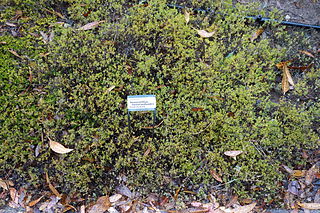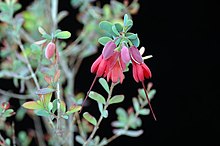
Homoranthus is a genus of about thirty species of plants in the myrtle family Myrtaceae and all are endemic to Australia. Plants in this genus share similarities with those in both Darwinia and Verticordia. They are shrubs with their leaves arranged in opposite pairs and with flowers appearing either singly or in small groups, usually in upper leaf axils. They are found in Queensland, New South Wales and South Australia. The genus was first described in 1836. None of the species is common nor are they well-known in horticulture.

Homoranthus wilhelmii, commonly known as the eastern feather flower, is a species of flowering plant in the family Myrtaceae and is endemic to South Australia. It is a small, spreading shrub with cylindrical to flattened leaves and white or pink flowers arranged in corymbs on the ends of branchlets. The distribution includes an area on the Yorke Peninsula, but it is most common on the southern Eyre Peninsula.

Homoranthus homoranthoides is a plant in the myrtle family Myrtaceae and is endemic to South Australia.

Homoranthus biflorus is a flowering plant in the family Myrtaceae and is endemic to a small area in northern New South Wales. It is an erect shrub with cylinder-shaped leaves and small groups of usually yellow flowers.

Homoranthus bebo is a flowering plant in the family Myrtaceae and is endemic to a small area in northern New South Wales. It is a low-lying shrub with leaves that are usually flat and with groups of up to ten yellow flowers. It is only known from the Dthinna Dthinnawan Nature Reserve near Yetman.
Homoranthus brevistylis is a plant in the family Myrtaceae and is endemic to a small area in Queensland. It is an upright shrub with pointed, linear leaves and groups of up to four pale yellow flowers in leaf axils. It is only known from the Blackdown Tableland National Park.
Homoranthus bruhlii is a plant in the family Myrtaceae and is endemic to a small area on the Northern Tablelands of New South Wales. It is an upright shrub with glabrous, pale green, linear leaves and with groups of three or four pale yellowish green flowers in leaf axils. It is only known from a single population near Tenterfield.

Homoranthus clarksonii is a flowering plant in the family Myrtaceae and is endemic to a small area in Queensland. It is an upright shrub with pointed, linear leaves and pairs of creamy pink to pale yellow flowers which turn pink as they age. It is only known from small populations on Mount Mulligan.
Homoranthus cummingii is a plant in the myrtle family Myrtaceae and is endemic to a small area in Queensland. It is an upright shrub with pointed, linear leaves arranged in alternating opposite pairs so they form four rows along the branchlets. The flowers hang downwards in pairs and are creamy white to pale yellow, turning red as they age. It is only known from Mount Zero north-west of Townsville.

Homoranthus decumbens is a plant in the myrtle family Myrtaceae and is endemic to a small area in Queensland. It is a low, spreading shrub with cylindrical leaves arranged in alternating opposite pairs. The flowers are yellowish green and arranged singly in upper leaf axils.
Homoranthus elusus is a plant in the myrtle family Myrtaceae and is endemic to a small area on the Northern Tablelands of New South Wales. It is an shrub with linear leaves and with groups of up to four flowers in leaf axils. It is only known from a single specimen collected near Tenterfield.
Homoranthus inopinatus is a plant in the myrtle family Myrtaceae and is endemic to a small area in southern Queensland. It is an upright shrub with linear leaves and with groups of three to six flowers in leaf axils near the end of branchlets. It is only known from a single small population on private property near Ballandean.

Homoranthus melanostictus is a flowering plant in the family Myrtaceae and is endemic to eastern Australia. It has cylinder-shaped to flattened leaves with blackish oil dots and up to six yellow flowers arranged in leaf axils near the ends of the branchlets.

Homoranthus montanus is a plant in the myrtle family Myrtaceae and is endemic to a small area in southern Queensland. It has narrow leaves and up to one to six small tubular, cream-coloured flowers arranged in leaf axils near the ends of the branchlets. As the flowers age, they turn red.

Homoranthus prolixus, commonly known as granite homoranthus is a flowering plant in the family Myrtaceae and is endemic to northern New South Wales. It is a spreading shrub with linear to lance-shaped leaves and groups of up to six yellow to red flowers in the upper leaf axils.

Homoranthus thomasii is a species of flowering plant in the family Myrtaceae and is endemic to Queensland. It is a small shrub with spoon-shaped, greyish green leaves and small, pendulous, pink flowers in the upper leaf axils.
Homoranthus tricolor, is a plant in the myrtle family Myrtaceae and is endemic to a small area in south-east Queensland. It is an upright shrub with linear to lance-shaped leaves and green, red and black flowers arranged singly or in pairs in upper leaf axils. It is only known from a single population near Mundubbera.

Homoranthus tropicus is a flowering plant in the family Myrtaceae and is endemic to tropical north Queensland. It is a shrub with curved, club-shaped leaves and white flowers in a corymbose-like arrangement on the ends of branchlets.

Homoranthus vagans is a flowering plant in the family Myrtaceae and is endemic to a small area in southern Queensland. It is a shrub with pointed linear leaves and groups of up to ten yellow flowers in leaf axils near the end of branchlets. It is only known from a single population north of Inglewood.
Lachlan Mackenzie Copeland(born 1973) is an Australian botanist, who obtained his PhD at the University of New England., with a thesis entitled Systematic studies in Homoranthus.
















